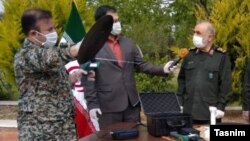Social media users in recent days are asking why a coronavirus detection machine "unveiled" in April by Revolutionary Guard as a "breakthrough" has not been put to use to prevent the new alarming surge in COVID cases. The Guards' spokesperson says it is "still undergoing verification testing".
Responding to a question from Rouydad 24 news website, Brigadier-General Ramezan Sharif, the spokesman of the Guards, said the machine is undergoing tests at hospitals and scientific centers. "The machine has proved a success in a major portion of the verification tests but has not reached mass production level yet," he was quoted by Rouydad 24 as saying.
In its article the website has said that people have a right to know what has been achieved by paying all the "material and immaterial costs" dedicated to the coronavirus detection device and asks why an invention that hasn't been fully tested should be "unveiled" by one of the highest officials of the Iranian military.
On April 15, Guard Commander Major General Hossein Salami appeared on the state-run television wearing a mask to say they had invented a super-device that could detect coronavirus. Salami claimed that the machine which consisted of several simple parts including a handheld detector with an antenna and a dish-like part, had been tested in various hospitals and had a reliability rate of about 80%.
According to General Salami the antennae of the device – called by the Qoranic name Mosta'an, one of the names of Allah -- contained "polarized viruses" that created a magnetic field and would point towards coronavirus anywhere within a radius of 100 meters in five seconds. It could be used for mass screening as well as finding contaminated areas and people and could even be developed further to detect other types of viruses, he said.
Iranian media say the machine was made by Kambiz Golshani, a self-proclaimed inventor famous for weird inventions, who sold it to the Revolutionary Guard in April for a hefty sum.
Three months later and as daily COVID deaths surged again, people keep teasing officials saying why the machine – which everybody knew was another dubious "breakthrough" and "invention" – has not been mass-produced.
When Mosta'an was "unveiled", jokes were made abundantly and the Health Ministry immediately announced that it had not issued a license for the machine. The Iranian Physics Association also issued a statement and said the claimed "invention" was "implausible and more like science fiction".
People made fun of the home-made-looking device and compared the dish to a cooking pot lid someone found in their kitchen.
Twitter was full of jokes on Monday by frustrated Iranians who are battling coronavirus, a devalued currency and fast rising prices.
One Twitter user commented that rather than being tested for its own veracity, the machine is putting the level of public respect for the Revolutionary Guards to test.
Another Twitter user mentioned the so-called invention in response to another user who was commenting on the huge devaluation of the rial. His reply to the first user who had said "no donkey could bring the economy to this point" was: "There are people who can make it drop as much as 400,000 but never mind, do you know anything about Mosta'an 110?"
A third Twitter user commented that authorities should have concentrated their efforts on mass production of Mosta'an 110 instead of masks and vaccines. "We could have exported it to earn some foreign currency and contain coronavirus at the same time'.









